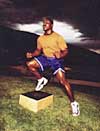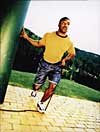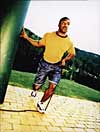SKIER'S HOP


Start with your left leg on the ground and your right leg planted on an 8- to 12-inch-high platform. In one motion, use your right leg to leap laterally over the platform and land in the opposite of the starting position. Repeat, leaping from side to side in a quick, controlled motion. Goal: Three three-minute sets.
SIDE-TO-SIDE
Anchor a sport cord—rubber tubing with handles (find one at )—to a stationary object. Don a waist belt, attach it to the sport cord, and lean far enough away to put tension on the cord. Hop on one foot laterally away from the anchor point, hold for two seconds, and then hop back to the starting position. Keep your legs slightly bent throughout. Goal: Two sets, 40-50 reps each.
ONE-LEG DIP
Like balance squats, but accentuates the quads more than the hips. Stand on your injured leg with the other leg balanced in the air behind you. Place one hand on a wall or chair for added stability. Slowly lower yourself until your thigh is 70 degrees to the ground and then stand back up. Add a sport cord for resistance. Goal: One three-minute set.
Also do: hamstring curls, leg presses, and calf raises. Three sets, 20 to 30 reps each, three times a week.
��


